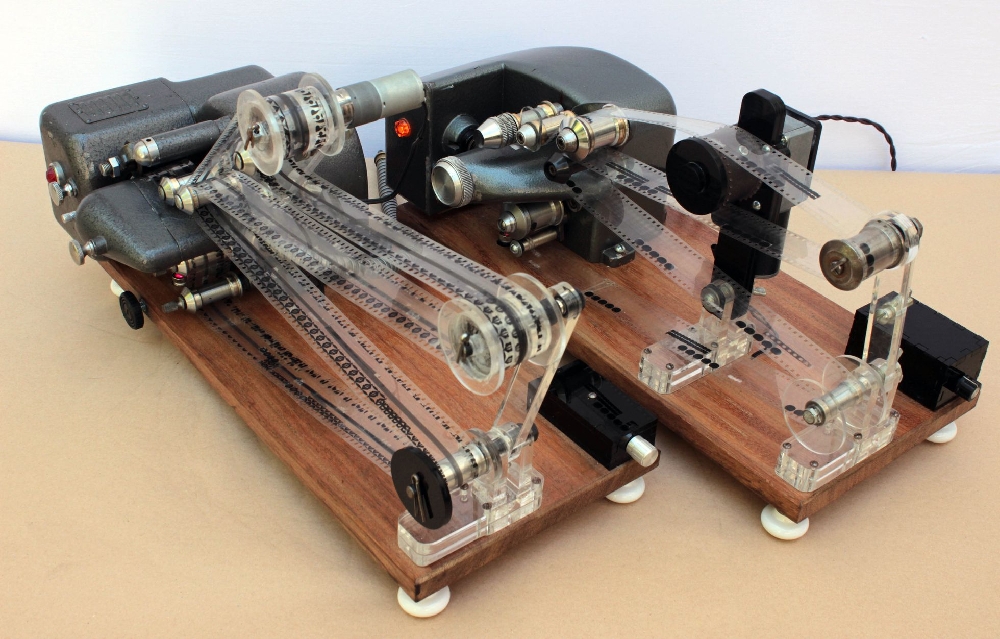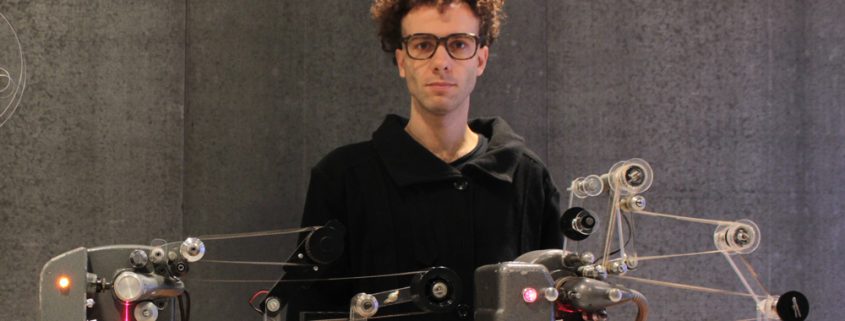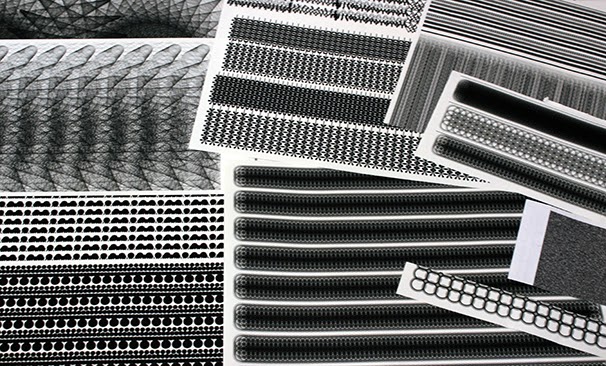Uncertainty Theory #30
About the Umbráfono by Enrique del Castillo and Daphne Oram
Audios
–Enrique del Castillo (Live) In Sonora - Captcha Family of the year 2020.
–Daphne Oram - Oramics (2007) Compilation of recordings from 1958-1977.
01. Adwick High School Nº.1 track 10
02. Rotolock track 12
03. Studio Experiment Nº.1 track 15
04. Adwick High School Nº.2 track 19
05. Adwick High School Nº.3 track 29
06. Studio Jinks track 44
07. Bird of Parallax track 3
Enrique del Castillo's Umbrafono

Umbra = Shadow
Fono = Sound
A piece that generates sound from the variations of light and shadow.
"Umbráfono" is a project by Enrique del Castillo (Jaén, 1982),
a performance with optical readers capable of transforming sound into luminous stimuli that are projected onto a cell
photosensitive. These luminous stimuli are generated by a beam of light passing through celluloid films.
The films are designed based on a scheme of relationship between wave frequency of the notes and repetition of geometric shapes,
so that harmonic sounds, noises, sound textures and atmospheres can be achieved.
About Enrique del Castillo
He began his music studies at the Ramón Garay conservatory for ten years and continued studying art at the universities of Granada,
Barcelona and Halle-Saale. Since 2007, he combines the two disciplines, starting to be interested in experimental music, participating in projects
such as Las barbas indómitas, Oniropompo, Chin yi, Possopotare, Tetenal, AMOR, and others.

In 2016 he received the first prize in the Preventive Music competition and The first PowSOLO International Sound Art Prize in 2020.
He has received grants for the development of experimental sound projects at Bilbaoarte in 2018 and at the Centro de Creación Contemporánea de Andalucia C3A in 2019.
He has developed works in collaboration with experimental and expanded cinema filmmakers between 2011/2019: collaborating with editor Violeta Tseli collective Gui Collec in the ARDA project and, above all, with the experimental filmmaker Miguel A. Puertas developing expanded cinema and experimental film pieces since 2010.
Interview for the program with Enrique del Castillo
1.- I find it very curious how you have approached your project.
You as Enrique del Castillo (not using a pseudonym or musical project name) and your instrument Umbráfono, which as a tool can be one or more "umbráfonos". I did not find information that you gave a name to a specific staging nor that the specific composition you perform on the tape has a name other than Film nºX. Is this the reflection of a special staging that goes beyond what we could consider an experimental music concert? How important is for you the nudity of the staging and that you can explain the mechanism of your tool and your compositional techniques? I must admit that I feel a political positioning whether it is premeditated or not in this way of acting.
A: I like to present the project under my own name, since I have had many others.
music projects and experimental music, (Las Barbas Indómitas, AMOR, Tetenal, etc) and so I do
a differentiation with a drift that is more of a personal artistic research than a project.
musical.
The fact that the clips are called Film No. X refers to the numbering of that film in
concrete. I have made about 200 films so far, and I have registered them. The name of
each sound composition is the number by which it is classified.
With respect to the staging, we are closer to a performance or "action" because of the interest
that has the execution of the show, in which we can see quite clearly how they work.
machines, their gears, we see films that stop playing when they are removed, etc.
In other words, there is a fairly direct relationship between the sound and what you see.
2.- How important is for you the analogical aspect of your project in these times?
Thinking specifically about experimental music and the contexts where you have been able to show your work, do you notice that you are going against the current?
Or that there are enough people also working on non-electronic instruments?
A: My inclination to work with analog instruments is simply a personal inclination, a
taste for it. This inclination contains a certain fascination for mechanisms.
I am certainly not the only one and there is an important movement of people working with this kind of
instruments, perhaps as a response to the vertigo of the lack of material referent implied by the
digital information.
I don't feel like I'm going against the tide because I'm very focused on my work and I find it very
natural. Perhaps from the viewer's point of view it may seem so, but it's not my opinion either.
intention to be reactionary to a context, but to investigate and compose.
3.- Evidently there is an investigation and a development in your story about the Umbraphone, do you feel that you have already exploited all the possibilities?
Do you see yourself creating more and more films nºXs that are nothing like what you have already managed to make sound?
A: I haven't exploited all the possibilities of the Umbraphone at all, it's quite infinite... the
following lines of research are e.g. ; frame composition by means of algorithms
mathematics, with JavaScript coding, research of sounds generated from developed
photochemical, research using stepper motors, speed control by photochemical systems, research using stepper motors, speed control by photochemical systems, research using stepper motors, speed control by
programmable devices such as arduino, explore the installation possibilities of the machine (adapting it to an
exhibition space for example), translation of antique ornamental patterns (provided they come from
of a mathematical pattern ) etc.
4.- Do you notice that the instrument itself and the staging make the spectator pay more attention to what is being done?
In other words, do you feel that the materiality of the instrument imposes itself, and transmits by itself, in addition to the fact that no matter how similar it may be
will never be the same again?
A: Of course, I think that the materiality of the instrument, its form, the mechanism, its
the sound of the machinery, the sight of the films themselves, are an essential part of the
of the performance. Nevertheless, all this physical structure of the performance has to be supported by
or rather they have to generate an acoustic performance that communicates something personal, original and
with artistic quality, so to speak. What is really important is what it sounds like. The
sound experience.
5.- You have philosophical ideas regarding the fact that the materiality of the tape (celluloid) can be so easily damaged, burned, destroyed,
etc. etc. Is your creativity also based on this?
A: With respect to film wear and tear, I have no philosophical position that would make it a
value. While it is true that wear and tear is an intrinsic condition of the material, which makes it evident
that what is being used is "matter" and not virtual or abstract data, so it is in
harmony with the whole project approach.
Execute performances with original films, single copies that deteriorate with use, gives
perhaps an added value to the show as a live event, as something unrepeatable.
However, it would not be contrary to any personal philosophical position to be able to make copies
photochemical copies of my original films. But right now there is no method of copying my original films.
altered negative.
Devising a way to do this is also an upcoming project in mind.
6.- Is there any experimental instrument that inspired you to make this one or did you later find some strange musical instrument?
that blew your mind and is related to the Umbraphone?
A: The truth is that I was not inspired by any instrument to make the umbráfono, although I knew more
late that some similar instruments were devised in the 1940s.
Daphne Oram's "Oramics" is also very closely related to my instrument, although the Oramics
is much more complex, it is a synthesizer, and its operation is actually quite different and the
results as well.
At this moment I don't know anyone who is working on the same path as I am, in that
I do feel a bit like a rara avis, unique in a discipline.
Although the world is very big and someone else will surely be there, even if we haven't been there yet.
still crossed.
7.- Are you thinking about recording an album or do you have the same philosophy as Martí Guillem, that the most important thing is the live performance, which also
is unique and unrepeatable?
A: The idea of a unique and unrepeatable live performance is not at odds with the idea of recording an album.
I would find it very interesting to do so. I can't do a desktop publishing right now, but I am
open to any proposal for recording or vinyl edition.
